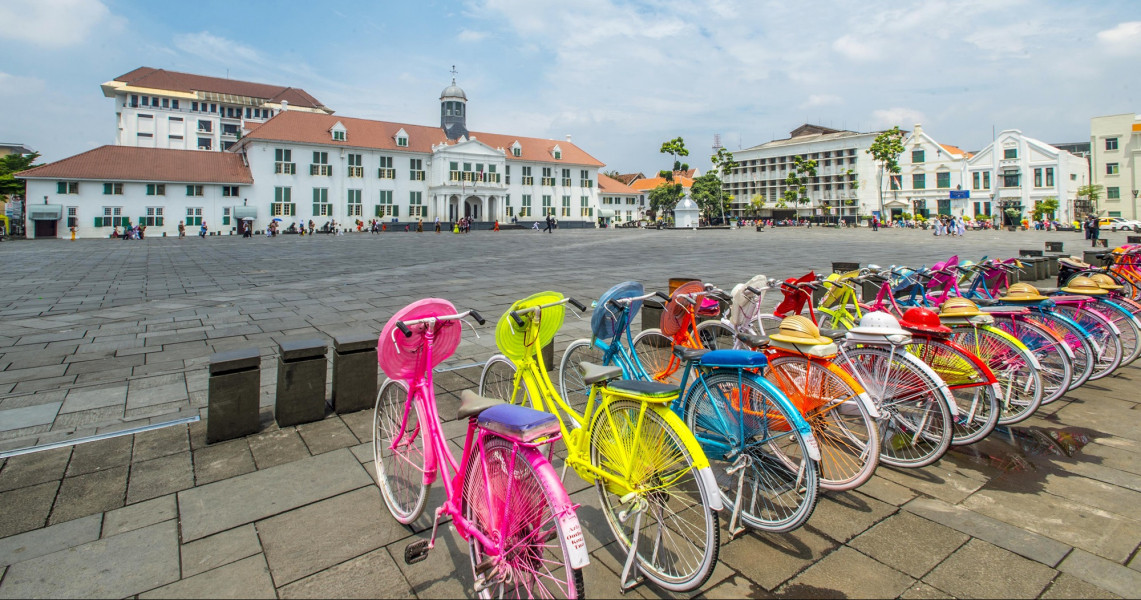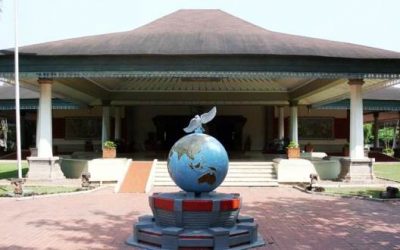Home / Batik Regions – Western Indonesia – Java Island – Jakarta / Kota Tua – Jakarta Old Town
Cultural Destination
Kota Tua – Jakarta Old Town

The Jakarta Old Town (photo: @Pesona.Travel)
Kota Tua – Jakarta Old Town
This ancient trading community was the seed of Jakarta as the capital city. It is the biggest Chinatown area in Jakarta, and it hosts a lot of historical and cultural occurrences even since before the time of the Dutch occupation. As the name already suggests, there are many historical buildings that were built in the colonialism era that are still standing. You can rent vintage bicycle at a museum and visit other museums next to it. There are also many cosy restaurants in this place that serve authentic Chinese-Jakarta culinary delights, as well as unique vintage photo gallery exhibitions.
Tourist Attractions in Jakarta
Setu Babakan – Betawi Cultural Village
This place will make you know and appreciate some cultural heritage of
Indonesian Stamp Museum
This quaint museum will bring you back to in time, to when smartphones and
National monument – The Monas
The monument was a “lighthouse project” designed to remind
Jakarta
Batik Motifs
Discover
Indonesian
Batik
Motifs
Gamolan
This motif illustrates Gamolan, a bamboo musical instrument of Lampung that is
Ake Patra
Ake is related to the divinity and the composition of the universe. It is a symbol of
Tifa Totobuang
The batik motifs illustrate Maluku’s traditional music instrument called
Sandeq
Sandeq Boat is a symbol of the maritime importance of the West Sulawesi region. The greatness of
Daun Simpor
This motif is inspired by the Simpor plant (Dillenia Suffruticosa) which is a typical
Honai
The Honai is inspired by the traditional house of the Papuan community living in
Besurek Rafflesia
The term “Basurek” refers to a textile that contains letters or inscriptions
Enggang Dayak
Local people beliefs that hornbills are an incarnation of the Commander of the Birds. It has supernatural
Gajah Way Kambas
The motif illustrates the Lampung’s natural reserve, the Way Kambas. it also symbolizes
Rangkiang
The word “Rangkiang” refers to the rice granary in the Minangkabau language. It symbolizes
Bultiya
The word ‘Bultiya’ is an acronym of the three major tribes in North Kalimantan, namely
Srimanganti
The name of the Srimanganti motif is derived from Palace’s hallway that connects to
Kawung
The Kawung motif was created by Sultan Agung Hanyokrokusumo (1593 – 1645) as a symbolic gift for
Gonggong Siput
Gonggong (Strombus Turturella) is one type of sea snail found around
Bintik Tujuh
The Bintik Tujuh (Seven Dots) motif has 7 white spots and green color gradation as
Tanah Liek
The word “Tanah Liek” refers to clay in Minang language. It is also known as
Prada Papua
The word “Prada” in the Javanese-Indonesian dialect means a batik textile that
Dayak Kamang
Kamang motif is generally found in the Dayak tribe shield because it is believed to
Ukir Sentani
The Ukir motif is a batik motif that is inspired by various traditional Sentani wood carvings
Karawo Pinang
Pinang refers to the Palm areca tree. This motif is considered as the original
Bekantan Pakis
This motif represents Pakis Haji (Polystichum setiferum), an endemic plant in
Lipaq Sabe
Lipaq Saqbe contains a simple geometric classical motif with various flower decorations. This textile is
Insang Ikan
Insang refers to the gills of the fish. This is a typical pattern of Malay ethnic who inhabits
Karawo Mahkuta
Mahkuta refers to Gorontalo’s traditional crown. It represents noble characters of
Tengkawang Ampiek
With its many advantages, the Dayaks use this leaf in ritual ceremonies. This plant is a symbol of
Pohon Hayat (Tree of Life)
The Batik motifs in Lampung are dominated by the acculturation of Buddhist and
Sekomandi
Its philosophical meaning is the eternal union which refers to a saying “until death do us part”
Pala Salawaku
This motif illustrates the unique weapons of the Maluku region, namely
Tikar Natuna
The Tikar Natuna motif is adapted from the traditional making of pandanus mats in
Wakatobi
It symbolizes the coastal beauty of the Wakatobi island and the symbol of Patra symbolizes
Angsa Duo
According to legend, the Angso duo batik motif is a pair of swans that are believed to have led Princess
Pati-Pati Pinehiku
It symbolizes the hierarchy in society and the social status of the Mekongga
Desa Na Tolu
The Desa Na Tolu characteristic pattern symbolizes the Batak philosophy of existence and
Tampuk Manggis Sasirangan
The motif illustrates the philosophy of the mangosteen fruit, which is
Leuit Sijimat
This motif reflects the daily activities of the Baduy tribe in Banten. The main ornaments of batik motif consist of:
Gumin Tambun
Based on Hindu mythology, this motif symbolizes lucks, abundant wealth, and
Mahkota Siger
Siger is the crown of a noblewoman in ancient time. It is a symbol of femininity, strength, and
Pinawetengan
The Pinawetengan Batik pattern was taken from a prehistoric inscription in
Tenun Bima
The motifs are adopted from Bima woven textile. This pattern has received a great
Manguni Minahasa
Manguni is identified as the symbol of the Minahasa people. Manguni is known as a
Buketan Bali
The Balinese bouquet (Buketan Bali) is a floral arrangement and the name is
Biji Kopi
The coffee seeds motif illustrates the pride of local coffee specialities in
Lontara
The Lontara script itself is a typical ancient script of Bugis and Makassar communities. History records that
Tabir Tanjung
Tanjung flower is a type of Cherry tree flower, which is commonly found in
Keluak Daun Pakis
The word “Keluak” is a Minang language which means twisted or tangled. The Motif of
Lok Baintan Floating Market
As you can imagine, the most authentic thing is that you can buy things and even
Tongkonan
Toraja’s traditional house is called Tongkonan. Tongkonan is a place for
Kerawang Tegak Aceh
The Vertical Upright (Kerawang Tegak) Motif symbolizes a person who has a strong
Dayak Taghol
Dayak Taghol has a distinctive style of four curved lines and small dots. This motif represents
Teguh Bersatu
This batik motif shows the strength of the people of Kupang. It also represents a sense of
Gedhog Kembang Waluh
a combination of Javanese cultural motif of the Majapahit kingdom (XII-XIV century) with
Ikan tambal
The word “Ikan” refers to fish. The philosophical meaning of Ikan Tambal means is
Gorga Simeol-Meol
The Gorga Simeol-meol is a pattern of plant tendrils. it is regarded as a symbol of longevity and
Pucuk Rebung Riau
Pucuk Rebung symbolizes heart determination in achieving goals, good luck, and
Kain Cual
Cual textile tradition has existed since the 17th century. The word “Cual” refers to
Tubo Kelapa
Coconut tree is a symbol of a good character and strong mentality. It illustrates the more success a person, the more
Parang Seling
Parang Seling or “alternating daggers” is a royal batik motif. It is a feminine variant of
Rumah Mamuju
the Batik motif illustrates the house of Mamuju King with the stairs, located on the left of the wooden stage house
Singayaksa
The Singayaksa motif comes from the name of a place where Sultan Hasanuddin used to
Jumputan Bintang
The word Jumputan means the tie-dye technique, while the word “Bintang” refers to
Gentala Arasy
Built as high as 80 meters, the tower also highlights the historical side of
Kaharingan
The Kaharingan or ‘tree of life’ based on the Dayak tribes’ belief system. This tree symbolizes
Daun Lada Hitam
The black pepper motif represents the main commodity of Bangka Belitung
Raja Ampat
Raja Ampat motif represents the marine life at Raja Ampat archipelago in
Kasih Tak Sampai
‘Kasih Tak Sampai’ is an idiom in the Indonesian language which refers to
Paqbarre Allo
The word “Barre” means round and “Allo” means the sunlight. This motif is interpreted as
Wirasat
Wirasat or divine inspiration is a gift from God. This inspiration is symbolized by
Sekar Jati
Sekar means flower and Jati refers to teak trees that symbolizes a strong mental character that
Malinau Cultural Festival
You will witness a unique competition that might not be found other than in
Tangerang Herang
Tangerang Herang motif is a symbol of Tangerang city. The Tangerang Herang batik motif consists of
Taiganja
Taiganja is a precious gold pendant that shows the social status of the Kaili family. It is





